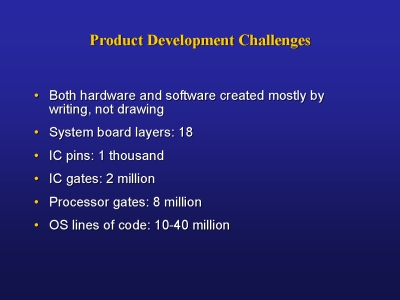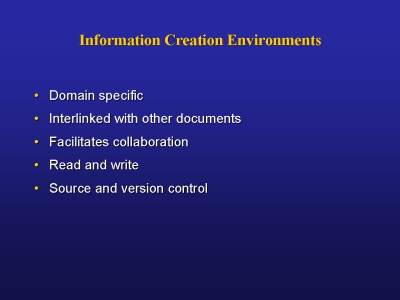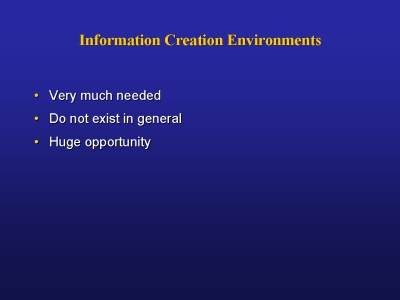Information and products Andy Poggio. 1.* - unedited transcript - The people who work for me say exactly the same thing. There goes my first boss, by the way, out of school. Talk about incredible luck. So, I want to spend just a minute giving you a pragmatic picture of why I care more than ever about the things that Doug is doing and things like open Hyper Document systems. As Doug said I work at Sun Microsystems. At Sun, we build computer systems of all sizes. We build little tiny ones. The Sunrays that we make are basically a frame buffer in a network interface, and really nothing else. We build big giant ones, Enterprise 10,000┬'s, with 10┬'s of processors, and gigabytes of memory, and terabytes of mass storage. I want to give you a brief picture into that world, and how what Doug is talking about really applies, and why we really need it. One of the changes that has happened over the last decade or so is it used to be that hardware people drew things, and software people wrote things. Well, it┬'s all looking more and more like software. Hardware people are doing a lot less drawing and a lot more writing than they used to. Everything is scaling up. System boards, you know, the circuit boards that go in your computer systems, have 18 layers and more of interconnections.
In a single integrated circuit, we┬'re moving above 1,000 pins into the area of 2,000 pins, just for one integrated circuit. Even the little thing that the silicon die connects on to that maps the pads on the die to the actual pins that come out is a little circuit board with a few thousand connections on it. Even those are problematic these days. Integrated circuit gates for Acex: 2 million and up, processors beyond that: 8 million and up, and operating systems lines of code 10┬'s of millions. This stuff is all essentially information, looks a lot like text in lots of cases, and it┬'s all being scaled because of Moore┬'s Law. All this stuff, including the size of software, is really being enabled by what we can do with Moore┬'s Law. What┬'s going even faster than that, which I think you┬'ll all recognize, is networking bandwidth. Networking bandwidth is going even faster than Moore┬'s Law, and that┬'s basically because of demand and optics, and a few things like that. Where as Moore┬'s Law says that everything doubles every two years or so, networking is going up by about a factor of ten every two years or so, outgrowing Moore┬'s Law, causing some interesting problems for us. So, all of this information interfaces to the other bodies of information, and there┬'s all kinds of opportunities to get it wrong. Most of these things are at least semi-automated if not highly automated, but there┬'s always a human aspect, and we┬'re always pushing what the tools can do, right, cause we┬'re always growing faster than the tools can be developed.
So you can make mistakes going from mapping the wafer to the pins in the IC, from the pins to the board, from the board to the software driver, from the driver to OS modules, from OS modules to other OS modules, and from the operating system to applications. All of those interfaces and more have opportunities to get it wrong, and it happens all the time. It┬'s not getting easier, it┬'s getting harder. So, there┬'s lots of information linking opportunities. An open Hyper Document system could tie together and make this all a lot easier to do.
The requirements documents, those go into specifications for products. Then there are hardware designs, interfaces, and the source code. Just like I said, Verilogue, which is what we do our Acex in, looks a lot like C, as does Java. There are software design interfaces in source code as well. There are external dependencies from suppliers and parts and partners and partners and strategic development relationships. There are schedules from per charge. There is user documentation and when you finally start chipping something, there are problem reports. All of this stuff should get tied together. They┬'re fairly elaborate systems for each little piece but there is nothing that ties them all together in some useable way and to make this tougher still, especially in silicon valley, people move around. All right, a processor these days takes four to five years to develop. You can expect something like a ten percent change of people working on it every year. So there are a lot of new people coming in. They need to get up to speed. They won┬'t see those links that some of the people that have been involved a long time will see. So if something overriding that ties this stuff together that gives you different detailed levels of view and automates a lot of this would be hugely, hugely valuable and any investment you make in this would be terrific. Today those environments are very domain specific. They have to be but they are interlinked well with the other domains.
There is nothing that facilitates collaboration except some basic things like source code control. It┬'s all got to work reading and writing. Reading is interesting but the creation part┬'s the writing and we need to do it with source and version control. So, I would love to see and hyper open document system come information and apply it across this kind of broad domain. That┬'s it.
---
Above space serves to put hyperlinked
targets at the top of the window
|

 Fig. 1
Fig. 1 Fig. 2
Fig. 2 Fig. 3
Fig. 3 Fig. 4
Fig. 4
 Fig. 5
Fig. 5